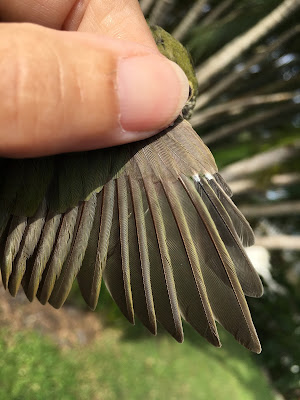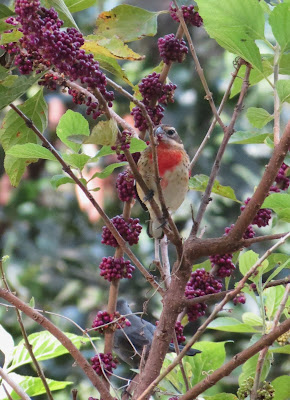Northern Cardinal
House Wren
On Tuesday we banded at Possum Long. Things have very much quieted down there. We had a visit from a marvelous Home School group. The 20 students and several parents got to see us band a Black-throated Blue Warbler. After that we did an exercise where the students found stick "bird legs" which they measured with a leg gauge and banded them with "color bands" made from drinking straws. No two combinations could be the same. We matched their leg measurement to a real bird size. One might think the stick is small but a lot of the sticks were the size of one of our largest bands! ( 5 = Eastern Screech-Owl!)
Color banding exercise
Black-throated Blue Warbler (female)
Photo by Robin Potvin
We did catch another Black-throated Blue Warbler and were packing up when one net produced three more birds to "save" the day. Two were green Painted Buntings and one was a Gray Catbird.
One Thursday we banded at PB 48. Our host has built a feeder that fit our traps and we had much more success there than on previous visits. We saw one bird that was previously banded, banded 13 more; 11 greens and 2 males!! Pretty good for only having seen 9 greens! I keep trying to tell folks that you cannot tell how many birds you have until there is something to differentiate individuals. There were still at least 2 unbanded green also.
We had two really interesting buntings and created a fun one. This bird got its Halloween colors.
Painted Bunting
One of the greens appeared to be a very young bird (second/late nesting??) as it was still molting. This is very strange considering that molt occurs on the breeding grounds or soon after an early (August) arrival. For those who have not seen previous molt photos on the blog, the white things are not bugs or damage, they are sheaths around growing feathers. It looks strange but is normal.
tail molting in - still quite short
molting in head feathers
molting in outer flight feathers (primaries)
Another bunting was molting but in this case the bird somehow lost half its tail and was growing in new feathers. This likely occurred within the week prior to our banding as there is active growth.
male Painted Bunting with tail replacement in progress
Total banded buntings Season 4 is now at 26. 55 to go to our 1000th banded bunting!
Next scheduled banding will be Tuesday, November 1. Nets go up at 7 am.

























































